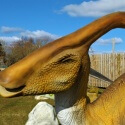
Distribution:
Parasaurolophus lived in Laramidia. During the Cretaceous period North America was divided by the Western Interior Seaway. The land to the east was called Appalachia and to the west was the island continent of Laramidia.
Time Period:
They lived during the upper Cretaceous Period which was 76.5-66 million years ago. This was the third and final segment of the Mesozoic Era. Until this time the continents which exist today were fused into one super continent called Pangaea. Although Pangaea had already begun to separate during the Triassic and Jurassic periods, the Cretaceous period saw it completely break apart and spread across the Earth’s surface. This change slowly cooled the Earth’s climate and the continents and oceans familiar to us today began to take form. The period ended in the mass extinction of the dinosaurs after an asteroid hit the Earth.
Size:
They were 9.5 meters (31ft) long, 5 meters (16ft) high and weighed 2.5 metric tons (the same weight as a large van)
Diet:
these dinosaurs were herbivores which mostly ate pine needles and leaves.
Interesting facts:
Parasaurolophus means ‘Crested Lizard’ and it got this name from the large crest on their heads which on males could be as tall as 1.8 meters (6ft), the same size as a tall adult human! It is thought that the crest was used to make trumpeting noises to communicate with others of their species. Younger ones would have made higher frequency noises that wouldn’t have travelled very far. However, fully grown adults produced low-frequency noises which would have travelled over much greater distances.
Most of the time they would walk on all four legs but could also balance on their strong rear legs when they wanted to. This would have been particularly helpful when they needed to reach food higher up in the trees. Their jaws used a grinding motion to chew their leafy diet and as such their teeth were constantly being ground down and replaced. It is also likely that they travelled in herds, like modern cattle do today and could have run at speeds up to 25 miles per hour.